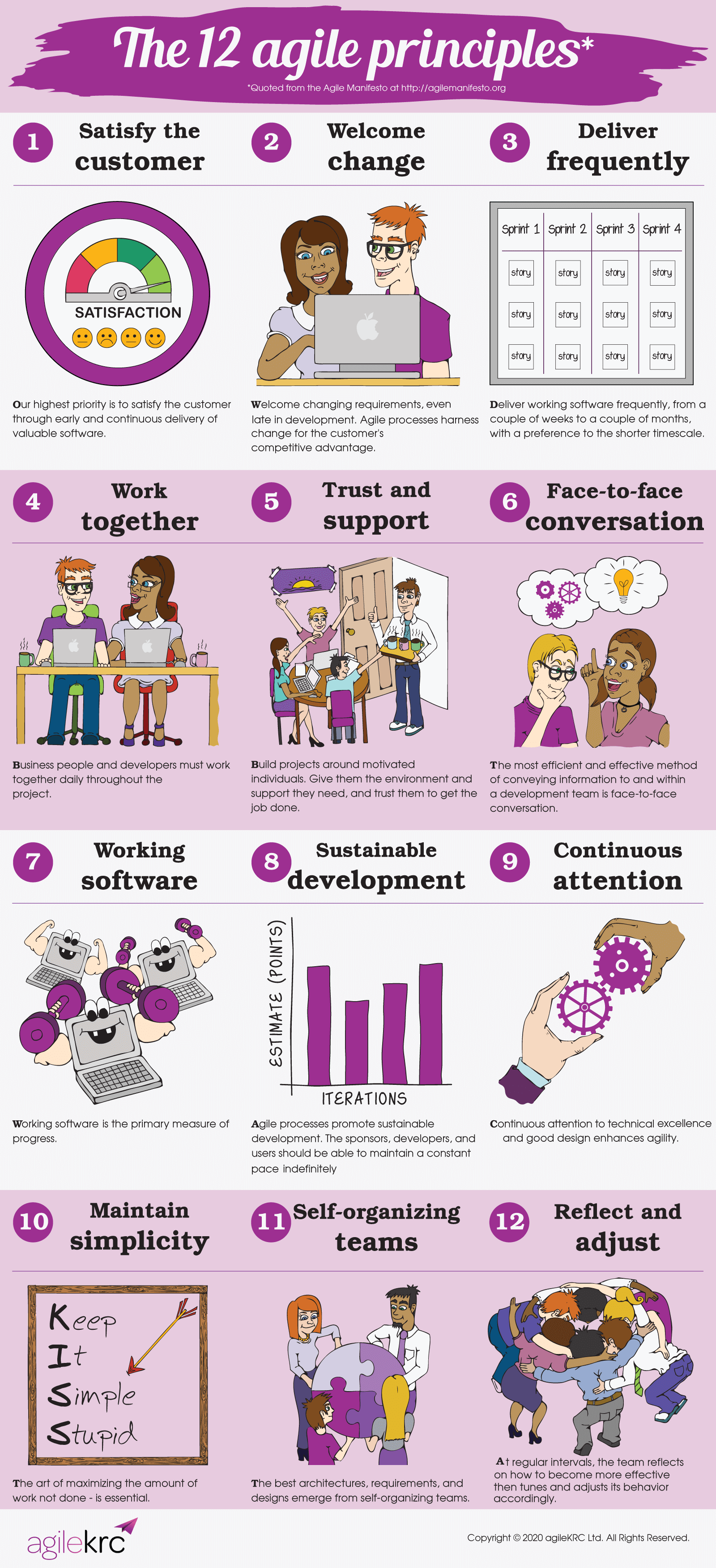
The Agile Movement in Software Development
Agile has become the software development industry’s go-to approach, owing its success to the 12 Agile Principles from the Agile Manifesto that enable the rapid and efficient production of top-quality software products.
A deep dive into the principles
The 12 Agile Principles serve as the foundation for the Agile methodology, affecting every facet of Agile project execution. In this article, we will take a closer look at these principles and their indispensable role in the effective implementation of Agile projects.
1. Our highest priority is to satisfy the customer through early and continuous delivery of valuable software.
The leading Agile principle focuses on fulfilling customer expectations by continuously and expeditiously delivering valuable software.
This principle accentuates the importance of producing a minimum viable product (MVP) that satisfies customer demands and can be developed within a limited timeframe.
By introducing a working product at an early stage, customers can critique the software’s performance and determine any necessary changes. This ascertains that the final product adheres to customer specifications and is delivered promptly.
2. Welcome changing requirements, even late in development. Agile processes harness change for the customer’s competitive advantage.
The second Agile principle promotes the embracement of changing requirements, even when development is well underway.
This principle accepts that requirements can alter as the development process unfolds, and the Agile methodology is tailored to accommodate these adjustments.
By welcoming change, the team can ascertain that the final product meets the customer’s evolving requirements.
3. Deliver working software frequently, from a couple of weeks to a couple of months, with a preference to the shorter timescale.
The third Agile principle emphasises the value of frequent delivery of operational software, with a preference for shorter periods.
This principle accentuates the importance of consistently presenting small, step-by-step enhancements to the software, rather than withholding delivery until the development cycle’s conclusion.
By utilising this approach, the team can ensure that the software is examined and authenticated at every stage of the development process, decreasing the chances of setbacks and errors.
4. Business people and developers must work together daily throughout the project.
The fourth Agile principle stresses the importance of maintaining steady collaboration between customers and stakeholders throughout the entire project.
This principle highlights the need for constant communication and feedback between the team, the customer, and other vital stakeholders.
By building a close working connection with the customer, the team can ensure that the software fits their needs and expectations, and by engaging stakeholders in the process, the team can ensure that the software upholds wider business aims and objectives.
5. Build projects around motivated individuals. Give them the environment and support they need, and trust them to get the job done.
The fifth Agile principle underscores the significance of building projects that include determined individuals, offering them the required setting and support, and placing faith in their skill to deliver the work.
This principle emphasises the development of an enabling environment where team members can function autonomously, take charge of their projects, and collaborate effectively with others.
By supporting individuals and trusting their judgement, the team can achieve improved results.
6. The most efficient and effective method of conveying information to and within a development team is face-to-face conversation.
The sixth Agile principle maintains that the most fruitful and impactful approach to relaying information within and to a development team is through face-to-face engagement.
This principle accentuates the pivotal role of communication in all Agile processes and claims that person-to-person interactions are the superior means for exchanging information, resolving disputes, and making determinations.
7. Working software is the primary measure of progress.
The seventh tenet of Agile practices underlines that the primary gauge of progress is working software.
This tenet highlights the significance of delivering a functioning product throughout each phase of the development progression.
By measuring progress based on the software’s functional qualities, the team can ensure they are offering value to the customer and achieving project aims.
8. Agile processes promote sustainable development. The sponsors, developers, and users should be able to maintain a constant pace indefinitely.
Agile’s eighth principle establishes that Agile processes nurture sustainable development, and all parties involved should be able to maintain a stable pace without limitations.
This principle highlights the necessity of a sustainable development approach, enabling the team to sustain a constant pace over long periods.
By circumventing long hours and burnout, the team can uphold high productivity and continuously provide exceptional software in the long run.
9. Continuous attention to technical excellence and good design enhances agility.
Within Agile practices, the ninth guiding principle highlights that ongoing focus on technical excellence and well-executed design strengthens agility. This principle reinforces the need for technical competency and quality design throughout the development process.
By emphasising these factors, the team can guarantee that the software is maintainable, scalable, and durable, increasing its agility and readiness to address changing requirements.
10. Simplicity – the art of maximising the amount of work not done – is essential.
The tenth Agile principle advocates that simplicity – the mastery of maximising the amount of work not done – is fundamental.
This principle highlights the importance of honing in on the crucial aspects and avoiding extraneous tasks.
By limiting the scope of work to be done, the team can reduce waste, heighten efficiency, and fast-track the product’s delivery.
11. The best architectures, requirements, and designs emerge from self-organising teams.
The eleventh tenet of Agile approaches recognises that self-organising teams are the most optimal origin of superior architectures, requirements, and designs.
This tenet upholds the team’s unparalleled knowledge and proficiency in software development.
By encouraging teamwork and enabling the team to make decisions, the team can create exceptional solutions that cater to the customer’s needs.
12. At regular intervals, the team reflects on how to become more effective, then tunes and adjusts its behaviour accordingly.
The twelfth Agile principle advocates that at regular intervals, the team should reflect on how to become more effective and modify their behaviour accordingly.
This principle affirms the importance of continuous improvement and feedback in the development process.
By consistently evaluating their performance and identifying areas for improvement, the team can enhance their efficiency, effectiveness, and overall quality of work.
Agile Principles: Ensuring Customer Satisfaction
The 12 Agile principles ensure customer satisfaction by providing a comprehensive framework for the product development process. They guide every step, from planning and development to testing and delivery, to ensure that the team delivers a high-quality product that meets the customer’s needs.
For instance, the first principle emphasises customer satisfaction through early and continuous delivery of valuable software. This principle guides the team to focus on delivering a minimum viable product that meets the customer’s requirements and can be delivered quickly. By doing so, the team can obtain feedback from the customer and adjust the product as necessary.
Similarly, the fourth principle emphasises collaboration with customers and stakeholders throughout the project. This principle guides the team to involve them in the development process, ensuring that the product meets their needs and aligns with broader business objectives.
The sixth principle emphasises face-to-face conversation as the most efficient and effective way of conveying information within the development team. The team prioritises face-to-face communication to ensure that information is shared effectively, and issues are resolved quickly.
The twelfth principle emphasises the team’s continuous improvement efforts. The team regularly evaluates its performance, identifies areas for improvement, and adjusts its behaviour to enhance its efficiency, effectiveness, and overall quality of work, and thereby ensuring the customer’s satisfaction.
Conclusion
The 12 Agile principles enhance business agility by providing a comprehensive framework for delivering high-quality software that meets the customer’s needs and aligns with business objectives. Collaboration, communication, feedback, and continuous improvement are the foundational tenets of these principles, enabling Agile teams to enhance their productivity, agility, and overall effectiveness.
The Agile principles also underscore the importance of adaptability and flexibility in today’s dynamic business landscape. By prioritising customer satisfaction, early and continuous delivery, and a rapid response to change, Agile teams can develop solutions that meet evolving needs and deliver real value to customers and the broader business.
The Agile principles provide a solid foundation for all Agile approaches and methods, guiding every aspect of the Agile development process. These principles emphasise collaboration, communication, feedback, and continuous improvement, which are critical in developing high-quality software that meets customer needs and adapts to changing requirements.
By following these principles, Agile teams can enhance their productivity, agility, and overall effectiveness and develop solutions that provide tangible benefits to the customer and the broader business, ultimately enhancing business agility.
agileKRC has helped shape agile thinking by leading the teams that developed AgilePM® and PRINCE2 Agile®. We take a practical, success-oriented approach. We begin by taking the time to listen and understand your needs, before offering our real-world experience and expert guidance.














